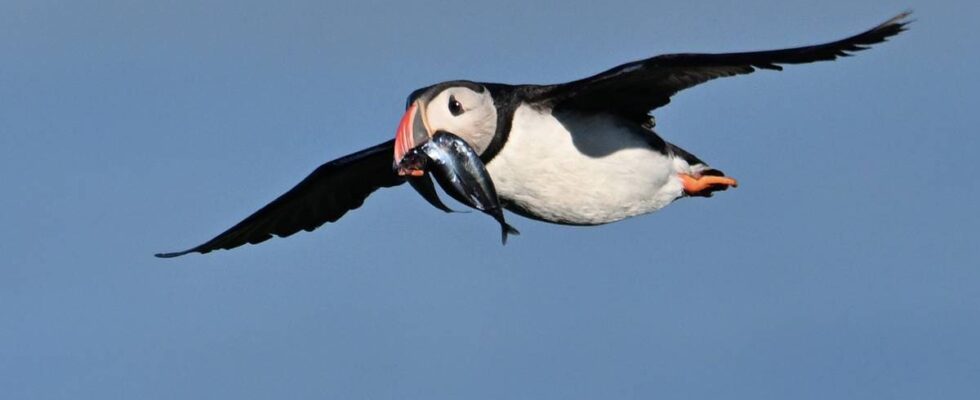The case in summary After 16 years of almost total mortality among puffin chicks on Røst, there has been a positive development in the last two years. At the end of the 70s, 1.4 million pairs of puffins nested on Røst, but now there are less than 200,000 pairs left. In 2016, only 6 percent of the puffin chicks survived the nesting period, but this year the majority of the chicks have left their nests. Warmer sea temperatures have led to the mackerel moving further north, which has been important for this year’s litter of puffin chicks. Although winter can be a challenging time for puffin chicks, scientists are optimistic about the future. The summary is made by an AI service from OpenAI. The content is quality assured by news’s journalists before publication. – For many years there have been absolutely miserable breeding seasons for puffins on the island of Røst outside Lofoten. That’s according to senior researcher at the Norwegian Institute for Natural Sciences (NINA), Tycho Anker-Nilssen. Over a period of 16 years, almost all puffin chicks died of starvation, but in the last two years there has been a change. This year’s summer was a new bright spot in an otherwise gloomy development. – It has been a useful year for the grove. It has been many years since we had a peak year for this species on Røst. Then we actually have to go all the way back to 2006. 100,000 puffin chicks on Røst “Parrot of the sea” are highly threatened in Norway. This means that the grove has a very high risk of dying out. At the end of the 70s, 1.4 million pairs of puffins nested on Røst. Now there are less than 200,000 pairs left, according to the senior researcher. Tycho Anker-Nilssen, senior researcher at the Norwegian Institute of Natural Sciences (NINA) Photo: Per Anders Todal / Dag og Tid – If half of the couples got a young on their wings, then there are around 100,000 young who hopefully have a chance to survive a little longer than the first days at sea. In 2016, only 6 percent of the chicks survived the nesting period. This year, however, the majority of the chicks have left their nests on Røst, says Anker-Nilssen. – It is very gratifying and exciting, says nature conservation advisor at BirdLife Norway, Martin Eggen. Eggen believes that we are living in a time of natural crisis and that lack of nutrition has been one of the really big problems for the seabird. Martin Eggen, Nature Conservation Adviser at the Norwegian Ornithological Association. Photo: PRIVAT – The number of seabirds in the bird mountains has decreased by 80 per cent in 50 years. We have all been waiting a very long time for things to turn around, because the stocks can come back. Bird numbers may increase, but they must find food. That has been the big problem, says Eggen. The puffin traditionally eats small fish. On Røst, fry of herring have been the most important prey. When the researchers saw that the herring spawning took place further north this year, they became concerned. However, warmer sea temperatures have contributed to the mackerel moving further north, which has proven to be very important for this year’s litter. Puffin with herring in its beak. Photo: Tycho Anker-Nilssen Mackerel on the menu Tycho Anker-Nilssen has researched the groves on Røst every year since 1981 and has never seen anything like it before. – It is completely unusual. With the exception of last year, we have to go all the way back to 1974 to find that mackerel was an important prey item for the groves out there. Lunde with mackerel fry at Røst. Photo: Tycho Anker-Nilssen / NINA – If the mackerel comes in and can be a good alternative for a longer period of time, then of course it is long-awaited. But both last year and this year, the mackerel fry only appeared at the end of summer. Therefore, it will be extra exciting to see both where and when the mackerel will spawn in the years ahead, according to the researcher. It will be decisive for what food the puffins can get hold of. – In order to raise the young, the puffins are dependent on finding small fish in the coastal current, within reach of the colony in the summer. Winter is coming Now that all the young have recovered and left the colony, a new challenge is coming, namely the first winter. – If they survive the first winter, that’s great. Then they have overcome the first obstacle, and then there is a chance that they can return to Røst after five or six years to breed, says Eggen. The puffins have to fend for themselves once they have left the nests. The first weeks of life as an independent puffin can be tough, and it is in winter that mortality is highest among the vast majority of seabirds, says Anker-Nilssen. Puffin on Hornøya near Vardø in Finnmark. Photo: Shutterstock – They are exposed both because of weather conditions directly, but also because weather and poor production in the sea can mean that there is little food that they can make use of. Although the winter can be tough, the researcher is optimistic about the future of the “sea parrot”. – Normally, more than 90 percent of the adult birds survive. Now we just have to hope that we enter a period of slightly better production in the sea, which can benefit many species and provide long-awaited recruitment to the puffins and our many other seabird populations that are struggling, concludes Anker-Nilssen. Published 29/08/2024, at 12.25 Updated 29.08.2024, at 15.14
ttn-69
The puffins at Røst survived – news Nordland

